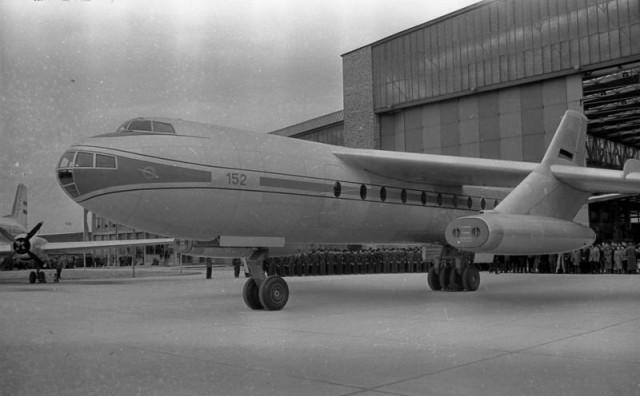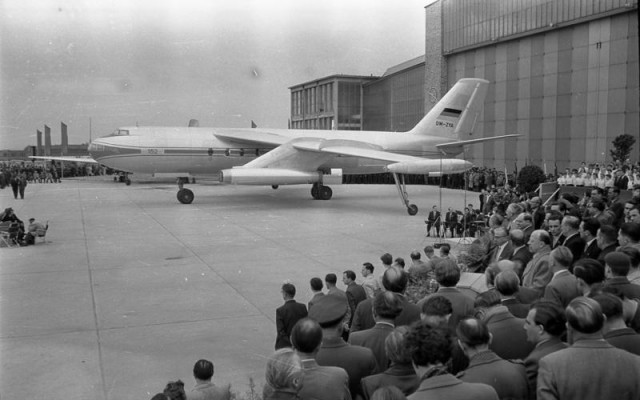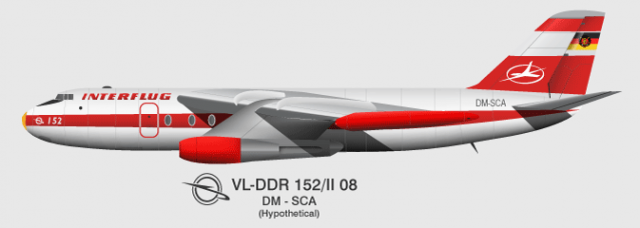The Junkers Ju-287 was never meant to be a transport plane; it was supposed to be another Nazi doom weapon that was nothing but the fever dream of Hermann Goering and his cronies. However, because of different circumstances, the aircraft would end up becoming Germany’s first airliner, the Baade 152 – which never entered service.
It was designed as a mid-winged monoplane bomber with either two or four BMW 003 engines, depending on the availability of basic aviation necessities like fuel and aluminum. It did have some notable technological advances for its time, however. It featured a forward-swept wing and (allegedly) a high cruise speed.
At the end of the war, the Soviets “inherited” a nearly-complete version of the Ju-287, which they called the OKB-1 EF-131. It had two wing-root mounted engines and a flight deck styled after the older Ju-88. When that design went nowhere, it was transferred to the Alekseyev Design Bureau [try not confuse Semyon Alekseyev with Rostislav Alekseyev – the father of modern wing-in-ground effect aircraft].
Semyon and his team came up with three aircraft based on the design of the EF-131. The I-21 high-speed interceptor, the I-212 high-speed interceptor with slightly newer engines than the I-21, and the I-150 light bomber. At the time, it was not well known that technically, Dr. Brunolf Baade was the designer of the aircraft, but much of Soviet aviation nomenclature defaulted to politics. Dr. Brunolf Baade was East German, and if his name was on the project there would have been less funding.
It was decided that none of these aircraft were satisfactory; in fact, only the I-150 had any metal cut for it. The program was canceled and one would have assumed that the program was dead.
Then on June 17, 1955, the Soviet-built Tupolev Tu-104 became the world’s first passenger jet airliner, which inspired the East German government to build their own. They wanted a companion aircraft that focused on the less-glorious task of domestic travel.
They sought a 70-seat regional airframe and Dr. Baade, now free to operate as a project leader, decided to take a gander at the “discard pile” of Nazi research. After finding nothing new, he resurrected his work from his time with Alekseyev. After all, East German sources described the I-150 as a victim of underfunding and cultural cringe – not a potential fire trap.
Not content with building a passenger jet airliner, the East Germans decided it would also be worthwhile to develop their own jet-engine: the Pirna 014. Designed entirely by repatriated Germans held in Soviet custody, it represents exactly where German turbine design left off in 1944.
However, by the time that the Baade 152 rolled out in the spring of 1958, it was already obsolete. Contemporary aircraft not only had fewer engines, but no longer were engines grouped into singular pods.
In December of that year, a second frame rolled out, equipped with Tumansky RD-9 engines; a notable absence of the locally-lauded Pirna. Sadly, the Pirna 014 had a nasty habit of blowing up during bench testing. Whether or not the problems were due to engine design or metallurgy are unknown, but it caused issues for the development of the aircraft.
The Tumansky-powered frame would later encounter engine problems itself, stall, and spiral dive into the ground, resulting in the death of all four test-crew onboard.
Things were clearly not looking good for the Baade 152. Before a serious fuel problem grounded the last two Pirna 014-powered test aircraft, only a little over an hour of test flying had been completed.
By 1961, Interflug– the launch and only customer- was flying Tupolev Tu-104s. The same year, the development Baade 152 aircraft were scrapped. All that remains now is a hulk that EADS is attempting to restore in Dresden. I wish them the best.
As for the Pirna 014? The completed engines were used as part of a gas-turbine assembly for a class of anti-submarine patrol boats. The core and any derivative parts never found their way back to aviation. Although the Baade 152 never saw passenger service, it is nice to know that an airframe has survived for many to enjoy for the years to come.




It’s clear a lot of thought and research went into this. Excellent piece, Bernie. I think history pieces are underrated and don’t get nearly enough love. Keep up the great work.
Fascinating article on a little-known piece of aviation history! The Baade 152 is amazingly modern-looking.
(It should be pointed out, however, that the Tu-104 was not the first passenger jet airliner; that honor goes to the DeHavilland Comet, which first flew in 1949 and entered commercial service in 1952. And a prototype jet airliner, the Vickers Nene Viking, first flew in 1945 but never entered production.)
The Soviets did not want the east german competition similar to what happened to the Canada built AVRO Arrow.